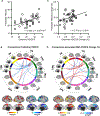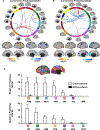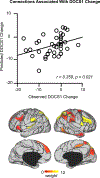Use of an Individual-Level Approach to Identify Cortical Connectivity Biomarkers in Obsessive-Compulsive Disorder
- PMID: 30262337
- PMCID: PMC6324977
- DOI: 10.1016/j.bpsc.2018.07.014
Use of an Individual-Level Approach to Identify Cortical Connectivity Biomarkers in Obsessive-Compulsive Disorder
Abstract
Background: Existing functional connectivity studies of obsessive-compulsive disorder (OCD) support a model of circuit dysfunction. However, these group-level observations have failed to yield neuroimaging biomarkers sufficient to serve as a test for the OCD diagnosis, predict current or future symptoms, or predict treatment response, perhaps because these studies failed to account for the substantial intersubject variability in structural and functional brain organization.
Methods: We used functional regions, localized in each of 41 individual OCD patients, to identify cortical connectivity biomarkers of both global and dimension-specific symptom severity and to detect functional connections that track changes in symptom severity following intensive residential treatment.
Results: Global OCD symptom severity was directly linked to dysconnectivity between large-scale intrinsic brain networks-particularly among the dorsal attention, default, and frontoparietal networks. Changes within a subset of connections among these networks were associated with symptom resolution. Additionally, distinct and nonoverlapping cortical connectivity biomarkers were identified that were significantly associated with the severity of contamination/washing and responsibility for harm/checking symptoms, highlighting the contribution of dissociable neural networks to specific OCD symptom dimensions. By contrast, when we defined functional regions conventionally, using a population-level brain atlas, we could no longer identify connectivity biomarkers of severity or improvement for any of the symptom dimensions.
Conclusions: Our findings would seem to encourage the use of individual-level approaches to connectivity analyses to better delineate the cortical and subcortical networks underlying symptom severity and improvement at the dimensional level in OCD patients.
Keywords: Biomarker; Connectivity; Dimension; OCD; Obsessive-compulsive disorder; fMRI.
Copyright © 2018 Society of Biological Psychiatry. Published by Elsevier Inc. All rights reserved.
Conflict of interest statement
Financial Disclosures
All other authors report no biomedical financial interests or potential conflicts of interest.
Figures





References
-
- Harrison BJ, Pujol J, Cardoner N, Deus J, Alonso P, Lopez-Sola M, et al. (2013): Brain corticostriatal systems and the major clinical symptom dimensions of obsessive-compulsive disorder. Biol Psychiatry 73: 321–8. - PubMed
-
- Harrison BJ, Soriano-Mas C, Pujol J, Ortiz H, Lopez-Sola M, Hernandez-Ribas R, et al. (2009): Altered corticostriatal functional connectivity in obsessive-compulsive disorder. Arch Gen Psychiatry 66: 1189–200. - PubMed
Publication types
MeSH terms
Substances
Grants and funding
LinkOut - more resources
Full Text Sources
Other Literature Sources
Medical

